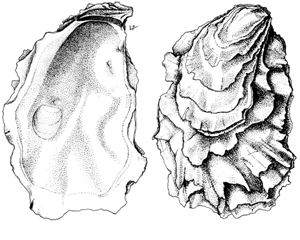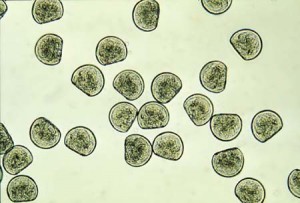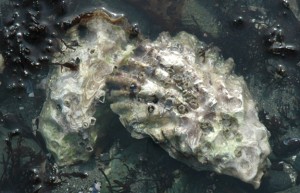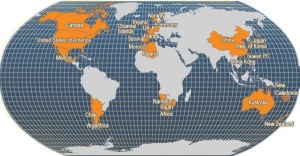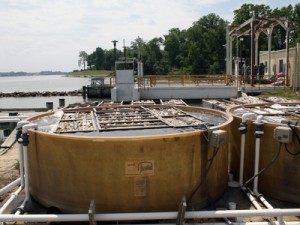The Pacific oyster, scientifically known as Crassotrea gigas, is a unique specimen with an interesting life and history. Each one begins with the sunshine, as water temperatures warm up to 20 degrees Celsius, mature adult males and females release their milt into the water column in a giant bloom of 50 to 200 million sex cells. Few of these eggs and sperm will actually meet, but when they do, the larvae floats along in the currents, growing micrometer by micrometer. They then develop a small foot, which they can use to move around slightly while they look for appropriate substrate to attach to for life. Looking for something around 75 to 300 micrometers in diameter, a small rock will do, but oysters prefer to find other oyster shells or fragments of shells to settle on because it means that another oyster previously lived there and was successful. After finding the perfect spot and settling on, they continue to grow and begin filter feeding their nutrients from the water. As they take sea water into their shells, they can choose to either use it for energy or pass it on through without digestion in order to keep from harm. Oysters have fluid genders, often beginning their lives as males and transitioning to females later, but things are interchangeable and intermittent, usually depending on conditions like the waters salinity and temperature as well as food supply. The pacific oyster will reach maturity at 1-4 years, also depending on the conditions of its habitat.
Pacific Oyster larvae 48 hours after fertilization, averaging 75 micrometers in size
Mature Pacific oysters, which can grow up to 30cm in length.
The Pacific oyster is native to Japan, but is now grown across the world. This is because of their ability to withstand a broad range of environmental conditions and to grow fairly rapidly. Many places around the globe introduced this species, either to replace a native species that had been wiped out or to create an oyster market where there wasn’t one. The introduction went smoothly, and this species is now grown in every continent except Antarctica.
Producers of Crassotrea gigas, FAO Fishery Stats 2006
Though they do have a fairly wide range of habitat conditions for an oyster, they still have specific needs. The water temperature should ideally fall between 8 to 25 degrees Celsius, but they can survive temperatures between -1 to 35 degrees Celsius. The optimal salinity of the water should be between 20% and 25%, but they will withstand salinities between 10% and 35%. They can be grown anywhere from 40 meters deep through the lower intertidal zone. They need enough algae, plankton and detritus present in the water to create a steady food supply.
Unfortunately, the Pacific oyster faces many problems, predators, parasites, and diseases. One huge issue facing shellfish as a whole is ocean acidification. Their shells are made from calcium carbonate, and as the pH of seawater is becoming more and more acidic they are having a harder time forming their shells which react with acid and growing. Oyster growers have reported finding increasingly more oysters with very thin shells or stunted growth, in addition to facing higher mortality rates. Physical predators include birds, sea stars, crabs, and moon snails. They also face a variety of parasitic predators that attack by drilling into their shells and sucking out the meat, including the Japanese oyster drill as well as predatory mussels, sea squirts, flatworms, sponges, seaweeds, hydroids, annelids, crustaceans, fungi, and diatoms. Another threat is that of diseases, which mostly occur exclusively in warmer or unhealthier waters. The only viral disease they face is the Herpes virus (occurring typically above 27 degrees Celsius), and bacterial diseases include Sporozoa and egg disease. They are also subject to several harmful bacteria that have been reported to infect oysters in the past. An additional hazard is the potential for falling vicitim to red tide, the bloom of certain microalgae containing specific dinoflagellates can drain the oxygen supply in the water and kill virtually all marine life present.
Due to these dangers as well as the over fishing by humans, wild oysters are not typically found anymore. Practically all modern-day oysters are born in a nursery and then cultivated. The good news is, there is always a steady supply of seed from a multitude of locations, and they ship well. A nursery must choose their broodstock, and often pick a mix of tetraploids (an oyster with four sets of chromosomes) and diploids (an oyster with two sets of chromosomes). This is because when you breed the two together you get a triploid oyster (having three sets of chromosomes), which are unable to spawn. An oyster that has just finished spawning tastes unpleasant for a couple months, and is not desirable in the market, so triploid oysters are preferred for growing. After a nursery chooses its oyster parents, they are placed in flow-through tanks that are continuously fed with algae supplemented water. The salinity is typically kept between 25% and 30%, and temperature at 20 to 22 degrees Celsius. A standard nursery keeps the oysters here for 6 weeks of hatchery conditioning so each oyster can have a full capacity of developed sex cells. There are then two methods to spawn them, the first is less common and called thermal shock treatment, where the oysters water temperature is increased to induce the release of milt. In the second method, they are manually opened, and the sex cells are removed with a pipette and mixed together. This method is preferred because it ensures the yield of millions of eggs, and workers are able to facilitate a biodiverse range of specimens. After fertilization of the larvae, they are placed in their own tank with UV treated, and filtered water kept between 25 to 28 degrees Celsius. After 14 to 18 days, nursery workers select the healthiest and fastest growing larvae and move them to a tank filled with appropriate substrate, usually other oyster shells. The baby oysters explore and choose a piece of substrate to settle on. Sometimes, they are shipped out immediately after this to be grown elsewhere, but most commonly they are grown here until they reach 3 to 5 millimeters in size before being moved to growing locations.
Oyster hatchery tank at University of Maryland center for Environmental Sciences
Farmers of the Pacific oyster have a variety of different options for growing, which are often selected depending on the conditions of the environment. In all aquaculture practices, the oysters are pre-attached to the substrate they will remain on for life. In bottom culture, the oysters are planted on firm ground, subtidal or intertidal, and covered, usually with a net, to protect them from predators. Off-bottom culture entails placing the oysters in mesh bags or plastic trays, which are then tied to wooden or metal frames to hold them in place, occurring typically in the lower intertidal zone. Suspended culture involves placing the oysters in mesh bags that are strung on a wire to be suspended and hung from a raft. This method is typically used in subtidal, deeper waters. In floating culture, they float on wood-framed trays lined with buoyancy devices and covered in tightly-woven mesh. Other than 2-3 months after an oysters is spawning, they can be harvested any time they reach market size, which is greater than 75 mm in shell length. Subtidal harvest methods are dredging or diving, intertidal methods include accessing by boat to hand-harvest or waiting for the tide to go out to gather them.
The Pacific oyster industry is a blooming one, reaching 750 million tons a year at its peak. Globally, Asian countries produces 88% of pacific oysters, the Americas (excluding U.S.A) produce 5%, Europe produces 4%, Africa produces 2%, Oceania produces 1%, and the U.S.A produces a measly 0.8%.
Written by: Mazzy Lattery
Bibliography:
“DISEASES.” Culture of the Pacific Oyster (Crassostrea Gigas). FAO Fisheries & Aquaculture Department, n.d. Web. 23 Feb. 2016.
“FAO Fisheries & Aquaculture Crassostrea Gigas.” FAO Fisheries & Aquaculture Department. N.p., 2016. Web. 23 Feb. 2016.
“Giant Pacific Oyster: Crassotrea Gigas.” Giant Pacific Oyster: Crassotrea Gigas. North Island Explorer, n.d. Web. 24 Feb. 2016. <http://northislandexplorer.com/molluscs/giantpacificoyster.htm>.
Pauley, G.B., B. Van Der Raay, and D. Troutt. 1988. Species profiles: life histories and environmental requirements of coastal fishes and invertebrates (Pacific Northwest)–Pacific oyster. U. S. Fish Wi ldl . Serv. Biol . Rep. 82(11.85). U.S. Army Corps of Engineers, TR EL-82.4. 28pp.
“The Hatchery Culture of Bivalves: A Practical Manual.” FAO Fisheries & Aquaculture Department. N.p., n.d. Web. 23 Feb. 2016. <http://www.fao.org/docrep/007/y5720e/y5720e0a.htm>.
Timmins-Schiffman, Emma, Michael J. O’Donnell, Carolyn S. Friedman, and Steven B. Roberts. “Elevated PCO2 Causes Developmental Delay in Early Larval Pacific Oysters, Crassostrea Gigas.” Marine Biology 160.8 (2012): 1973-982. EBSCOHOST. Web. 23 Feb. 2016.
“World Production of Aquaculture.” FAO Fisheries & Aquaculture Department <http://www.nmfs.noaa.gov/aquaculture/docs/aquaculture_docs/world_prod_consumtion_value_aq.pdf>.


